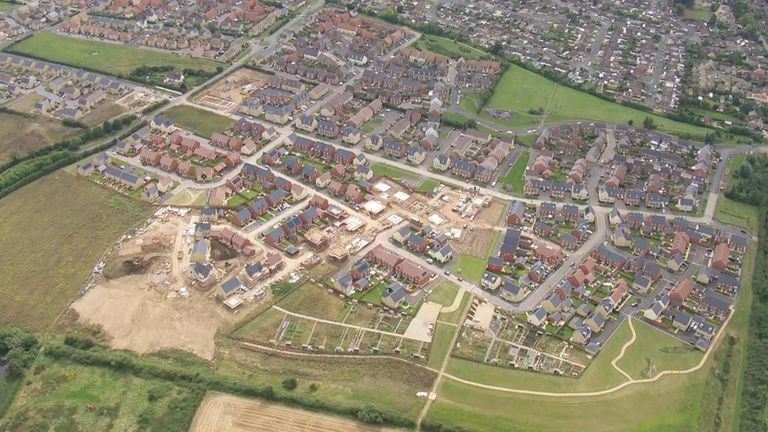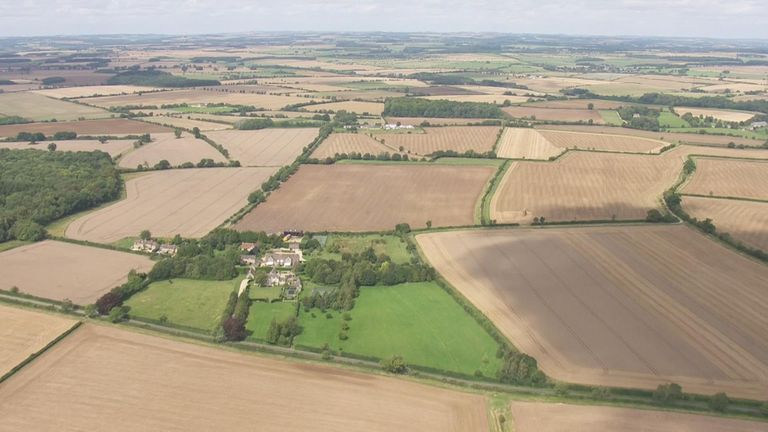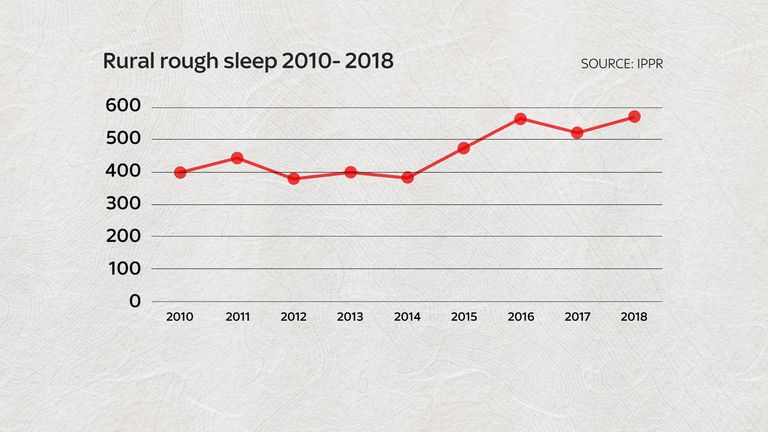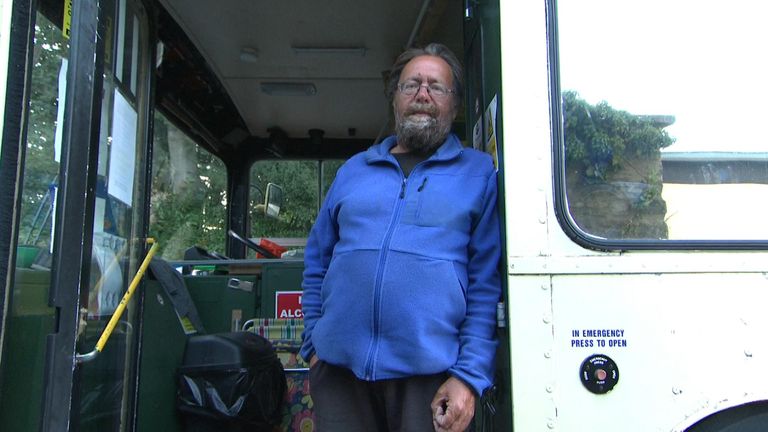The number of social homes being built in rural England has fallen by more than 80% in the last six years.
Exclusive research for Sky News has found just 1, 309 social houses were built in rural areas in 2017 – 18, despite hundreds of thousands of thousands of people stuck on long waiting lists.
Sky News and the Institute for Public Policy Research (IPPR) can reveal that social housing – previously known as council housing – has fallen by 83% between 2011 – 12 and 2018.

“When we look at the type of housing that is being supplied, generally the amount of social rent being supplied is significantly short of what is needed,” said Jonny Webb, a researcher at the IPPR.
“Across the country, we think that there should be the need for around 100, 000 social-rent houses per year and that should be supported with the dedicated grant funding and subsidy needed to actually get those houses built.
“What we believe at the IPPR is that it’s imperative for the government to support an ambitious housebuilding program geared towards social rent.”
Official figures show the number of new homes built each year is higher in rural areas compared to urban areas – but the government says it is focusing efforts on building affordable rent homes rather than social housing.
In fact, the IPPR says the amount of affordable rent housing has risen by 97% since 2011 – 12, while social housing has fallen by 83%.

Affordable rent homes tend to be let at 80% of market value, while social housing is rented at a much lower rate, and in many cases is the only option for those on low income.
The IPPR says one reason for the stark fall in social housing is that for developers, affordable classed homes can be more profitable.
Mr Webb said: “Part of the issue is that developers tend to favor building affordable rent houses because they know that they can be rented out at a higher rate and they can get higher rates of return in terms of their rent.
“But it’s also to do with the way that the government grant and subsidy is targeted towards house-building so what we’ve seen since 2012 is the amount of availab le grant funding for building and supporting the development of sub-market housing has significantly been geared towards affordable rent housing.
“So housing developers and house builders actually find it much easier to get the grant funding they need to make the profits they desire on the affordable rent housing. “

The struggle to get on the housing ladder in predominantly rural England is tougher than in urban areas.
Last year, lower house prices were 8.8 times the average lower wage in rural areas, compared with 7.5 times in predominantly urban areas, excluding London.
A spokesperson from the Ministry of Housing, Communities and Local Government told Sky News: “Housing is a priority for this government and last year we built more homes overall than in all but one of the last 31 years.
“Since 2010, the government has focused on creating more homes for affordable rent as opposed to social rent across the country and we’ve delivered 430, 000 of these, including over 139, 000 in local authorities with significant rural areas. “

The rural housing crisis is also having an impact on the number of homeless – with exclusive figures for Sky News showing rough sleeping across rural England is also on the rise.
The IPPR says that between 2012 and 2018, the number of rough sleepers has increased by (%.)
However, these numbers are only official figures registered by local authorities – the actual number of rural homeless is likely to be much higher.

“In terms of the challenges that both homeless people and rough sleepers face, these are significant and they’re all the more pronounced in rural areas,” Mr Webb said.
“Some of the issues that rough sleepers might face in urban areas such as exposure to the elements, difficulties in accessing healthcare services, difficulties in accessing accommodation, these are all the more pronounced in rural areas.
“So things like the dispersed nature of rural geography and the difficulties in accessing transport links, these are all additional problems that rural rough sleepers have to deal with. “
Meet the villagers affected by the need for social housing
Residents in the rural village of Twyning, near Tewkesbury in Gloucestershire, have been pushing back against further housing developments.
They say previous developments have harmed their village – but have not made the area more affordable for those on low inco me.
Many say young people have been priced out of the area by high rent, while others have been made homeless.
This is what some of those living in Twyning had to say.

Sarah and Paul Holden, who have lived in the village for 10 years, moved to the area for its safety and sense of community.
Ms Holden said: “We chose Twyning because it’s a community – so the children could have local friends, so it’s safe cycling around on the roads, so I could walk the dog across fields. “

She said that if developers continue to build on greenbelt land “everything we’ve moved for won’t exist any more”.
“We’ve satisfied what we had to provide for new homes for the community and they have to stop, because we’re a village and we cannot keep building, building, building on our wonderful countryside.
“It’s just ridiculous.”
Mr Holden said that the houses being developed are “not for people on low income, they’re for middle-class high earners” and will therefore not solve the social housing problem.

“This is the countryside and they’re trying to make it into a town”
Maggie Ball, who was born in Twyning, says she understands the need for housing but the new builds are going for “eye-watering sums” .
She said: “The villagers have always said our young can’t come back to the village where they were born and brought up because they can’t afford it.
“Well they still can’t afford it.”
She believes at least five more developers want to build on fields in the area.
“This is the countryside and what they’re trying to do is make it into a town, “Ms Ball said.
“There has to be a limit somewhere”

Vicky and Adam Walker were hoping to buy a home to live in with their two young children.
But they could not afford to buy and were put on the social housing list.
They say they have an “idyllic” life in the village – but it is at risk of being destroyed by over-development.
“If we were suddenly to have another 170 houses, I don’t think that the ability of the village would cope with that, “they said.
“The roads, just the whole space of everything. I don’t think it’s equipped to do that, so it would become very crammed, very congested.”
“It’s impossible to get on the property ladder – we’re effectively homeless”

Kimberley Harris and Brandon Luce, both in their early 20 s, say it is too expensive to buy a home in the area.
The couple, who work as a receptionist and supermarket worker, started privately renting a flat for £ 690 a month.
Ms Harris said: “Brandon got a second job to help out with the bills but we were managing.
“Sometimes when things got tight, we didn’t have any food and we had to get food bank vouchers.”
But when the landlord had a relationship split and had to move back into the home, the young couple were evicted and had no option but to register themselves as legally homeless.
They were put in a Travelodge for three weeks and now live in a temporary accommodation bedsit at £ 682 a month.
They said: “When we were evicted, at one point we couldn’t see any light at the end of the tunnel.
” The house prices here are just extortionate.
“You look at properties advertised and you think, I’m not going to earn that in my entire life.
” Some places you would have to save up for nine years to even get the deposit together . “
” Rural homelessness is harsher than in a city “

David Byrd, 58, was evicted from his home after he had issues paying his rent and has been homeless since May.
“I gathered a few possessions and left the flat I’d lived in for 14 to 15 years, “he explained.
“I just thought, right I’m going to have to make it on the streets. It was hard. It was ve ry much fend for myself.
“I used to get up at 3am or 4am and go round the bins, especially on a weekend, picking out chips and things like that to feed myself.”
Mr Byrd set himself up outside the relative safety of an M&S but soon found it did not offer enough shelter when the weather took a turn for the worse.
He is now living in a double-decker bus which has been converted into a homeless shelter run by a charity called The Big Yellow Bus Project.
:: Listen to the New Lines podcast on Apple Podcasts ,Google Podcasts,Spotify,Spreaker
The 58 – year-old says that although it is a wealthy area, many people are still struggling to afford to live: “It’s not just a struggle for the homeless .
“There’s a lot of people, they’ve still got their homes but they’re on benefits and they’re struggling to make ends me et.
“They’re basically living from hand to mouth all the time.
” Rural homelessness is harsher than in a city. I imagine being homeless in a city, there’s more places to go than there would be out in the countryside.
“If this bus hadn’t been here, I don’t know what really would have happened to me. “







GIPHY App Key not set. Please check settings